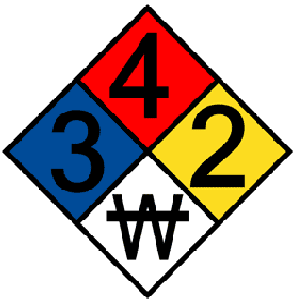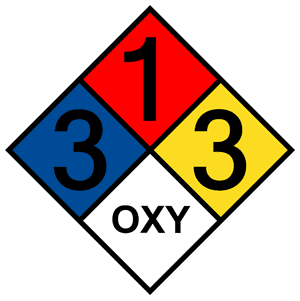- Home
- Environmental Health & Safety
- Fire Safety
- Hazards Of Materials
Standards of Identifying the Fire Hazards of Materials (NFPA 704)

What is the scope of the standard?
The standard addresses the health, flammability, instability, and related hazards that may be presented by short-term, acute exposure to a material during handling under conditions of fire, spill or similar emergencies. It provides instructions for providing a simple, readily recognized, easily understood system of markings that provides a general idea of the hazards of chemical materials stored and/or used in a space (such a teaching or research laboratory) and the severity of these hazards as they relate to handling, fire prevention, exposure, and control.
What is the meaning of acute health effects?
The hazard ratings reflect the acute effects of a chemical material which involve short-term (minutes or hours), high concentrations and immediate deleterious health effects (e.g., severe burns, respiratory failure, coma, death, irreversible damage to a vital organ). Acute exposures are usually related to an accident such as a chemical spill, massive skin splash, and fire. Acute exposures, typically, are sudden and severe and are characterized by rapid absorption of the chemical that is quickly circulated through the body and damages one or more of the vital organs.
What are the objectives of the standard?
The objectives of the system are:
- to provide an appropriate signal or alert and on-the-spot information to safeguard the lives of emergency response personnel (e.g., firefighters, HAZMAT responders).
- to assist in planning effective fire and emergency control operations, including clean up.
- to assist all designated personnel, engineers, plant, and safety personnel in evaluating hazards.
What is the purpose of the standard?
The NFPA 704 diamond system is intended to provide basic information to firefighting, emergency, and other personnel, enabling them to more easily decide whether to evacuate the area or to commence emergency control procedures. It is also intended to provide them with information to assist in selecting firefighting tactics, appropriate personal protective equipment, and emergency procedures.
How is the degree of hazard severity positioned and indicated to reflect potential acute health and/or safety hazard?
The NFPA 704 sign consists of four diamonds within a larger diamond. The red, flammability diamond is at "12 o'clock"; the yellow, instability diamond is at "3 o'clock"; the white, special hazards diamond is at "6 o'clock" and the blue, health hazard diamond is at "9 o'clock".
The degree of hazard severity for a chemical liquid or solid - flammability, health hazard, instability is indicated by a numerical rating that ranges from four (4), indicating the most severe hazard to zero (0), indicating no hazard.
Flammability - the greatest volume of one numerical code (4,3,2,1,0) determines the marking. The exception to this rule - if a more severe code has a volume of 3 gallons of more, then that code is used instead of a lower code of greater volume. Total lab volume less than 1 pint - hazard rating 0
Health and Instability -

the most severe rating code regardless of volume - professional judgment is allowed in making a decision that may deviate from a strict interpretation of this definition
Compressed Gases
The presence of a compressed gas cylinder is indicated by the symbol "G". It is always placed in the diamond that reflects the characteristics of the hazard. The size of the gas cylinder is not a factor in decision-making.
| Flammable gas | "G" placed in red diamond |
| Poisonous or corrosive gas | "G" placed in blue diamond |
| Oxidizing gas | "G" placed in yellow diamond |
| Inert gas | "G" placed in white diamond |
Special Hazards
Special hazards are indicated in the white section that is located in the lower region of the 704 sign. There are two special hazard categories:
- Water reactive - Chemicals that demonstrate unusual reactivity with water are designated by the letter W with a horizontal line through the center W.
- Oxidizers - Chemicals that decompose readily under certain conditions to yield oxygen are designated by the symbol OX. They may cause a fire in contact with combustible materials, can react violently with water and when involved in a fire can react violently.
What has the University done to comply with this standard?
The University is in compliance with the NFPA 704 standard. The EHS office has developed a computerized database of all the chemical inventories in the teaching and research laboratories. Based on these comprehensive inventories, which were prepared by lab science faculty and their lab staff, EHS staff affixed coded, NFPA diamonds on all doors leading to these chemical inventories. The codes will be updated periodically with the collaborative efforts of the EHS office staff and the lab personnel.